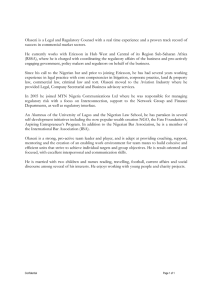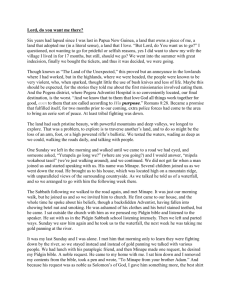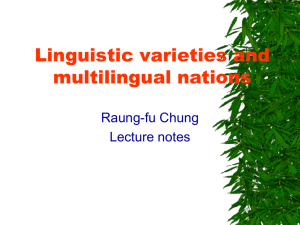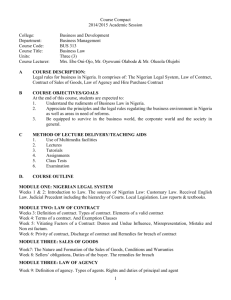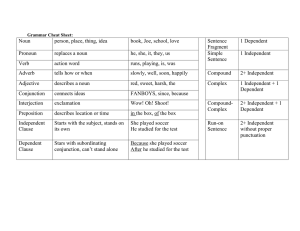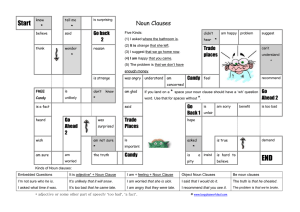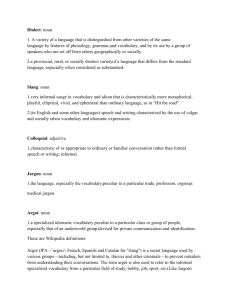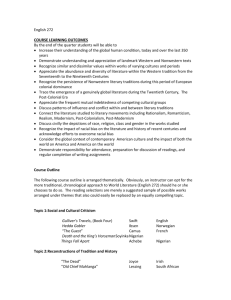A Basic Description and Analytic Treatment of Noun Clauses in
advertisement
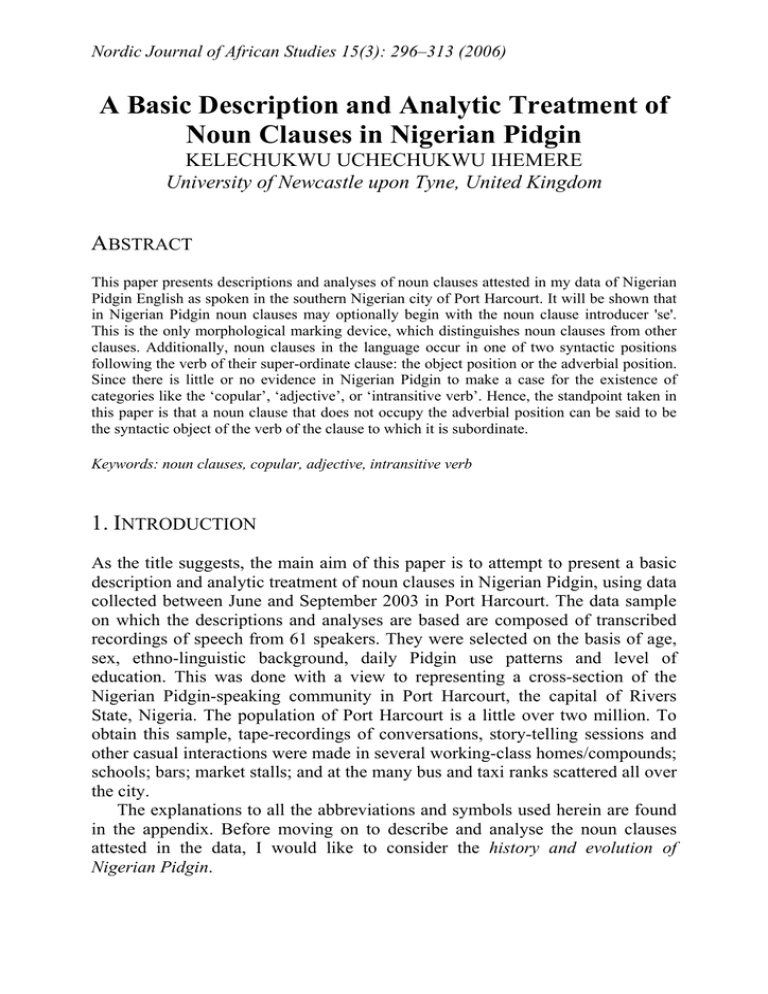
Nordic Journal of African Studies 15(3): 296–313 (2006)
A Basic Description and Analytic Treatment of
Noun Clauses in Nigerian Pidgin
KELECHUKWU UCHECHUKWU IHEMERE
University of Newcastle upon Tyne, United Kingdom
ABSTRACT
This paper presents descriptions and analyses of noun clauses attested in my data of Nigerian
Pidgin English as spoken in the southern Nigerian city of Port Harcourt. It will be shown that
in Nigerian Pidgin noun clauses may optionally begin with the noun clause introducer 'se'.
This is the only morphological marking device, which distinguishes noun clauses from other
clauses. Additionally, noun clauses in the language occur in one of two syntactic positions
following the verb of their super-ordinate clause: the object position or the adverbial position.
Since there is little or no evidence in Nigerian Pidgin to make a case for the existence of
categories like the ‘copular’, ‘adjective’, or ‘intransitive verb’. Hence, the standpoint taken in
this paper is that a noun clause that does not occupy the adverbial position can be said to be
the syntactic object of the verb of the clause to which it is subordinate.
Keywords: noun clauses, copular, adjective, intransitive verb
1. INTRODUCTION
As the title suggests, the main aim of this paper is to attempt to present a basic
description and analytic treatment of noun clauses in Nigerian Pidgin, using data
collected between June and September 2003 in Port Harcourt. The data sample
on which the descriptions and analyses are based are composed of transcribed
recordings of speech from 61 speakers. They were selected on the basis of age,
sex, ethno-linguistic background, daily Pidgin use patterns and level of
education. This was done with a view to representing a cross-section of the
Nigerian Pidgin-speaking community in Port Harcourt, the capital of Rivers
State, Nigeria. The population of Port Harcourt is a little over two million. To
obtain this sample, tape-recordings of conversations, story-telling sessions and
other casual interactions were made in several working-class homes/compounds;
schools; bars; market stalls; and at the many bus and taxi ranks scattered all over
the city.
The explanations to all the abbreviations and symbols used herein are found
in the appendix. Before moving on to describe and analyse the noun clauses
attested in the data, I would like to consider the history and evolution of
Nigerian Pidgin.
A Basic Description and Analytic Treatment of Noun Clauses
2. THE HISTORY AND EVOLUTION OF NIGERIAN PIDGIN
Here, I look at Nigerian Pidgin and its speakers and attempt to answer the
question of whether the language is a Pidgin or Creole. I also explore the genesis
and development of Nigerian Pidgin.
2.1 NIGERIAN PIDGIN AND ITS SPEAKERS
Nigerian Pidgin is said to be one in a line of English-lexifier Pidgins and Creoles
spoken along the West African coast and in African Diaspora communities
spread along the Atlantic basin. Among these related Pidgin varieties, the
Cameroonian Pidgin is closer in form to Nigerian Pidgin than are, for instance,
Sierra Leonean and Jamaican Krio. However, these Pidgins and Creoles have in
common a significant number of semantic, grammatical and phonological
features and structures.1
It is estimated that there are over 75 million people who speak Nigerian
Pidgin as a second language, and the number of first language speakers is put
roughly at between 3 and 5 million. These numbers are increasing all the time
because the Nigerian Pidgin is very popular with younger members of the polity,
who constitute a greater number of the population of Nigeria, which is estimated
to be about 133 million. Nigerian Pidgin is the most widely spoken language in
the country. It is different from the other 400 or so Nigerian languages because
members of every regional, ethno-linguistic and religious group in the country
speak it. It is further distinguished from the Nigerian Standard English (NSE)
due to the fact that it is spoken by members of every socio-economic group,
while only those Nigerians with many years of formal education can claim to
speak Standard English with any proficiency. Knowledge of Nigerian Pidgin is
fast becoming indispensable for everyday practical communication and the
understanding of issues affecting the Nigerian.
It is rather disappointing to note that despite the overwhelming evidence
within Nigeria that Nigerian Pidgin is in all respects the most logical choice for
a national language, it is accorded little or no recognition by Nigeria’s language
policy planners and administrators. Official attitudes towards Nigerian Pidgin
remain largely negative, sustaining flawed notions passed on from the colonial
era that Nigerian Pidgin is some type of ‘broken English’.
2.2 PIDGIN OR CREOLE?
Based on my observations in Port Harcourt, I tend to agree with Faraclas (1996:
3) that the name Nigerian ‘Pidgin’ is to some extent misleading, since the
1 See Faraclas, 1996; Kulick, 1997; Sebba, 1997; Holm, 2000.
297
Nordic Journal of African Studies
Nigerian Pidgin-speaking community includes people who speak the language
as a pidginised speech form, as a creolised speech form and/or as a decreolised
speech form. For example, for an Ikwerre market woman whose use of Nigerian
Pidgin is restricted to business transactions, the language is a Pidgin in the true
sense of the word. For her children who speak Nigerian Pidgin to their Kalabari
schoolmates, the language is depidginising or creolising. For the Igbo man who
speaks Nigerian Pidgin with his Efik wife, and especially for his children, who
speak Nigerian Pidgin with their parents and each other, the language is not
Pidgin at all, but a Creole. For the child from an elite Port Harcourt family who
grows up speaking Nigerian Pidgin, but who hears Nigerian Standard English at
home, on formal occasions, at school and on the radio and television, Nigerian
Pidgin is in all probability a decreolised speech form.
For the sake of convenience, Nigerian Pidgin can be divided into three sets
of social lects. Firstly, acrolectal (decreolised) varieties which show significant
influence from Nigerian Standard English. Secondly, basilectal (pidginised or
repidginised) varieties which show significant influences from other Nigerian
languages, and thirdly, mesolectal (creolised) varieties which typify the speech
of those who use Nigerian Pidgin in most of their daily interactions or who have
learned Nigerian Pidgin as a first language. It is common in practice for most
speakers to change their lect or variety of Nigerian Pidgin in accordance with
social context. For example, a bank clerk may use a basilectal variety in the
market, a mesolectal variety with colleagues at work and an acrolectal variety
with his line manager. However, this study adopts mesolectal varieties of
Nigerian Pidgin for all descriptions, analyses and examples, unless otherwise
stated (see also Faraclas, 1996).
2.3 GENESIS AND DEVELOPMENT OF NIGERIAN PIDGIN
Nigeria’s expansive and vigorous population and age-long tradition of ethnic
and linguistic diversity and forbearance led to the emergence of a highly
mercantile society with large urban centres centuries before the landing of
Portuguese merchants who traded pepper and slaves from the Nigerian coastal
area. The Portuguese first arrived in Benin (city) at the end of the 15th century.
From the mid 16th century, the British took over as major trading partners. With
the abolition of the slave trade at the beginning of the 19th century, British
colonial interests shifted to agricultural production for exportation to Europe.
However, even before these contacts with Europeans, city life, intermarriage,
trading and travel brought Nigerians who speak different languages into close
contact with one another for thousands of years. Thus, bilingualism and
multilingualism have always been practiced in most parts of Nigeria. For these
reasons, it is very likely, according to Faraclas (1996), that a pidginised form of
Nigerian languages existed and was in use many centuries before the arrival of
the first Europeans. Support for this claim is found in northern Nigeria around
298
A Basic Description and Analytic Treatment of Noun Clauses
the Lake Chad basin where non-native speakers of Hausa use a pidginised form
of Hausa in the markets while a pidginised variety of Igbo is spoken at present
in some Niger Delta markets in the south.2
As has been highlighted above, Nigerian Pidgin may well have developed
from one or several such pidginised Nigerian languages that were spoken along
the coast before the arrival of the Europeans. However, owing to the importance
of the European trade and the reluctance of the Europeans to learn other
languages, European words might have been substituted for Nigerian words for
ease of communication. Since the Portuguese arrived first, a few Portuguesederived words like sàbi ‘know’ and pìkîn ‘child’ would have been initially
adopted, but as the British colonial dominance over Nigeria increased, more and
more English words would have been integrated into the language. With British
colonial administration came European education through missionaries, many of
whom were Krio speakers from Sierra Leone – mostly ex-slaves or descendants
of ‘repatriated’ slaves from the Caribbean.
With Faraclas (1996), I would argue that it is impossible to say for certain
whether Nigerian Pidgin developed from marketplace contacts between
European traders and the various ethnic groups along the coast or from the
influence of missionaries from Sierra Leone. We can assume, however, that both
of these factors played some part, but it is important that scholars exercise some
care not to over-emphasise the role of either the traders or the missionaries in the
evolution of Nigerian Pidgin. In the frantic search for origins, creolists typically
ignore the fact that, at every stage of its history, Nigerian Pidgin has been used
primarily as a means of communication among Nigerians rather than between
Nigerians and traders, missionaries or other foreigners. From the evidence
available it is difficult if not impossible to state clearly any cogent synopsis for
the origin and evolution of the Nigerian Pidgin that does not assign a significant
role to impact from the linguistic models with which southern Nigerians have
always been the most familiar: the structures that typify the languages of
southern Nigeria.
Having given a brief outline of the Nigerian Pidgin-speaking community and
the origin and evolution of the language, I now move on to present descriptions
and analyses of its noun clauses.
3. NOUN CLAUSES
Following Faraclas (1996), I argue here that in Nigerian Pidgin grammar all
noun clauses may optionally begin with the noun clause introducer se. This is
the only morphological marking device, which distinguishes noun clauses from
other clauses. Noun clauses occur in one of two syntactic positions following the
verb of their superordinate clause: the object position or the adverbial position.
2 For more details on the origin of Pidgins and Creoles see Mafeni, 1971; Shnukal &
Marchese, 1983; Goodman, 1985; Winford, 1997; Holm, 1989, 2000.
299
Nordic Journal of African Studies
A noun clause may also follow an adverbial clause introducer, in which case it
can be taken to be part of a larger adverbial clause. Equally, there is little or no
evidence in Nigerian Pidgin to suggest the existence of categories like the
‘copular’, ‘adjective’, or ‘intransitive verb’, hence a noun clause that does not
occupy the adverbial position can be said to be the syntactic object of the verb of
the clause to which it is subordinate. Therefore, noun clauses in Nigerian Pidgin
may be divided into two categories: object noun clauses and adverbial noun
clauses:
1. Object noun clause
A
tink
[se dem kuk
rais].
1sP thinkF [ncI 6sP cookF rice]
‘I think they cooked rice.’
2. Adverbial noun clause
Im
tel
mi
se
‘chop rais’ [se hongri du
3sP tellF 1oP ncI eatF
mi
finish].
rice [ncI hungry doF 1oP +C]
‘(S)he told me, ‘eat the rice’ because I was hungry.’
3. Noun clause as part of an adverbial clause
A
go
kuk stu
[if
[se
1sP −R cook stew [avcI [ncI
yu
bai mit]].
2sP −R meat]]
‘I will cook stew if you buy meat.’
3.1 SEMANTIC REPRESENTATION OF NOUN CLAUSES
There is little if any evidence in Nigerian Pidgin as regards the morphosyntactic
criteria to differentiate one type of object noun clause from another, however the
semantics of object noun clauses varies significantly, depending on the
semantics of the main clause verbs for which they function as objects.
300
A Basic Description and Analytic Treatment of Noun Clauses
3.1.1 Noun Clauses as Objects of Verbs of Cognition
Verbs of cognition or perception in most instances take noun clause objects:
4. Yu sàbi
mi.
2sP knowF 1oP
‘You know me.’
5. Yu
2sP
sàbi
[se
A
knowF [ncI
de
Port Harcourt]
1sP cvF Port Harcourt]
‘You know that I am in Port Harcourt.’
6. Yu
si
mi
2sP seeF 1oP
‘You saw me.’
7. Yu
si
[se
A
2sP seeF [ncI 1sP
de
Port Harcourt]
cvF Port Harcourt]
‘You see that I am in Port Harcourt.’
3.1.2 Noun Clauses as Objects of Verbs of Speaking and
Showing
The structures used for direct and indirect speech are very similar, both are
composed minimally of a verb of reporting such as tok ‘talk’ or tel ‘tell’
followed by a noun clause. The major distinguishing feature between direct and
indirect speech in Nigerian Pidgin is that while the pronominal person categories
of the original utterance are maintained in direct speech constructions, they are
converted to those appropriate to the reporting situation in the case of indirect
speech:
8. Dem tok
6sP
[se ‘Wi
de
Port Harcourt’].
talkF [ncI 2sP cvF
Port Harcourt]
‘They said, “We are in Port Harcourt.” ’
301
Nordic Journal of African Studies
9. Dem tok
6sP
talkF
[se
dem de
Port Harcourt]
[ncI
6sP cvF
Port Harcourt]
‘They said that they are in Port Harcourt.’
3.1.3 Noun Clauses as Objects of Verbs of Interrogation
Broadly, the most commonly utilised structure for both direct and indirect
reporting of questions are made up of a verb of interrogation such as aks ‘ask’
accompanied by a noun clause object. As in the case of direct and indirect
speech the pronominal persons of the original utterance are preserved in
questions reported directly, while they are changed to match the reporting
situation in the case of indirect questions. In addition, an oblique hearer and/or
object may be inserted between the verb of interrogation and the noun clause
object. However, reported questions are set apart from reported speech in that
the verb of interrogation may not be followed by a valence-increasing verb.
These statements become clearer when we take a look at the examples below:
10. Direct yes – no questions
James
aks
mi
[se ‘Yu
go
maket
?’]
James
askF 1oP [ncI 2sP goF market Qù]
‘James asked me, “Did you go {to the} market?” ’
11. Indirect yes – no questions
Ema aks
mi [se
weda
a
go
maket].
Ema askF 1oP [ncI whether 1sP goF market]
‘Ema asked me whether I went {to the} market.’
12. Direct question-word questions
Sam aks
mi
[se ‘Weting dem giv
yu
for maket?’]
Sam askF 1oP [ncI what? 6sP giveF 2sP p market]
‘Sam asked me, “What did they give you at the market?” ’
302
A Basic Description and Analytic Treatment of Noun Clauses
13. Indirect question-word questions
Ema aks
mi
[se
Ema askF 1oP [ncI
dem giv
mi
weting for maket].
6sP giveF 1oP what?
p
market]
‘Ema asked me what they gave me at the market.’
Below are further examples of noun clause objects of verbs of interrogation:
14. Chime aks mi
[se hu
giv
mi weting for wer?].
Chime askF 1oP [ncI who? giveF 1oP what? p where?]
‘Chime asked me who gave me what where.’
15. Ada aks
mi
[se
weting dem give
Ada askF 1oP [ncI
mi].
what? 6sP giveF 1oP]
‘Ada asked me what they gave me.’
16. Nsirim aks
mi [se dem aks
yu
[(se) weting]].
Nsirim askF 1oP [ncI 6sP askF 2oP [(ncI) what?]]
‘Nsirim asked me what they asked you (about).’
On rare occasions in Nigerian Pidgin, a verb of speaking may be used in both
direct and indirect questions in place of a verb of interrogation:
17. Im tel / tok
mi
[se
weting dem giv
3sP tellV+ talkF 1oP [ncI what? 6sP giveF
mi].
1oP]
‘(S)he asked me what they gave me’. OR ‘(S)he told me what they
gave me.’
It is also possible in indirect questions for a relative clause or a headless relative
clause including a question word to be substituted for a noun clause, if an
oblique hearer-object is present:
18. (a) Im aks
mi
di ting we a
kuk. OR
3sP askF 1oP ar thing rcI 1sP cookF
303
Nordic Journal of African Studies
(b) Im aks
mi
(se – ncI) weting
3sP askF 1oP
what?
a
kuk.
1sP cookF
‘(S)he asked me what I cooked.’
While the noun clause introducer se is permissible in constructions similar to the
second example in 18b, se is not allowed in sentences such as the one in 18a.
3.1.4 Noun Clauses as Objects of Requesting/Commanding
The structure used for both direct and indirect reporting of commands is similar
to the construction employed for direct and indirect statements. In most
instances, the same verbs of speaking are used in the superordinate clause,
although as Faraclas (1996: 32) reports, other verbs such as wont ‘want’ are
possible here as well but the noun clause objects of these verbs must embody an
imperative subjunctive clause:
19. Im
tel
mi
[se ‘(Mek yu)
kuk!’]
3sP tell 1oP [ncI (SJcI 2sP) cookSJ]
‘(S)he told me, “cook!” ’
20. Im
tel mi
[se mek
3sP tell 1oP [ncI SjcI
a
kuk].
1sP cookSJ]
‘(S)he told me to cook.’
21. A
tok
[se
mek
dem
no
kuk].
1sP talkF [ncI SjcI
6sP
ng
cookSJ]
‘I said that they must not cook.’
3.1.5 Noun Clauses as Objects of Copular Verbs
All copular verbs in Nigerian Pidgin may take syntactic objects under certain
conditions. For this reason and because the category adjective is absent and
primarily replaced by stative verbs, which also accommodate syntactic objects,
it becomes very difficult to establish a special class of predicate noun clauses
that is not identical in nearly every way to the well-motivated class of object
noun clauses. Sentences such as the ones below in numbers 22, 23, and 24 can
be said to motivate the assignment of the noun clauses in 25 and 26 to the class
of noun clause objects:
304
A Basic Description and Analytic Treatment of Noun Clauses
22. A
de
Port Harcourt.
1sP cvF Port Harcourt
‘I am in Port Harcourt.’
23. Moni
de
mi
for porket.
Money cvF 1oP
p pocket
‘I have money.’
24. Yu
bi
jentulman,
2sP cvF gentleman
i
no
bi
–am
3sD
ng
cvF -3oP
?
Qù
‘You are a gentleman, isn’t that right?’
25. Di
wahala
bi
[se
yu
bi
jentulman].
ar
trouble
cvF [ncI 2sP cvF gentleman]
‘The trouble is that you are a gentleman.’
26. I
bi
3sD cvF
laik [se
yu
go
Aba].
cx [ncI 2sP goF Aba]
‘It seems that you went to Aba.’
3.1.6 Noun Clauses as Objects of Mental State Verbs
Stative verbs that tell us about human sentiments and emotions like gud ‘be
good’, bad ‘be bad’ or hapi ‘be happy’ can also take noun clause objects:
27. I
gud
[se
yu
go
Aba].
3sD be goodF [ncI 2sP goF Aba]
‘It is good that you went to Aba.’
28. I
gud
[se
mek
3sD be goodF [ncI SJcI
yu
go Aba]
2sP
F
‘It is good that you go to Aba.’
305
Aba]
Nordic Journal of African Studies
29. A
hapi
[se
you go
1sP be happyF [ncI 2sP
Aba].
goF Aba]
‘I am happy that you went to Aba.’ OR ‘I am happy because you went
to Aba.’
The two glosses in example 29, point to the fact that two interpretations are
often possible for this type of sentence, depending on whether the noun clause is
taken to be occupying the object position as in the first gloss or the adjacent
adverbial position in the second gloss.
These interpretations are more fully illustrated by the verb veks ‘angry’,
which allows more flexibility in the assignment of semantic role to its syntactic
subject than does hapi:
30. A
1sP
de
־C
veks
[se
be angryF [ncI
you
kuk
rais].
2sP
cookF rice]
‘It is making me angry that you cooked rice.’ OR ‘I am getting angry
because you cooked rice.’
31. Im de veks
3sP
־C
mi
[se
yu kuk rais].
be angry 1op [ncI 2sP cook rice
‘It is making me angry that you cooked rice.’ OR ‘I am getting angry
because you cooked rice.’
The object noun clause of example 30 is roughly equivalent to example 32:
32. [Se
yu
kuk
rais] de
[ncI 2sP cookF rice] ־C
veks
mi.
be angry 1oP
‘That you cooked rice is angering me.’
While the second gloss of example 31 could be restated as in 33 below:
33. [Se
yu kuk
rais] na
im
{mek} a
[ncI 2sP cookF rice] E1 3EP {SJcI} 1sP
de
veks.
־C
be angry
‘You cooked rice, (that) is why I am getting angry.’
306
A Basic Description and Analytic Treatment of Noun Clauses
3.1.7 The Use of Se in Different Types of Noun Clauses
I concur with Faraclas (1996: 34) that in Nigerian Pidgin noun clause initial
position se is always optional and never obligatory. However, se is
accommodated in certain environments while it is not in others. For instance, se
is more likely to occur:
a) Before directly reported (quoted) speech, questions, or commands;
b) Before a pronoun;
c) After a copular verb or a mental state verb; or
d) When the noun clause is shifted to sentence-initial position.
Se is less likely to be used:
a) Before a question-word in indirectly reported questions and
b) After the focus introducer na.
3.2 NON-FINITE NOUN CLAUSES
3.2.1 Multiple Functions
The categories ‘verb’ and ‘noun’ are not in most cases clearly demarcated. A
large number of the lexical items grouped as verb or noun may equally belong to
either category. When a lexical item leaves a particular category, it drops the
arguments, modifiers, and auxiliaries appropriate to the category it leaves and
takes on those of the category it enters. However, in most instances a particular
item may leave one category without undergoing any form of morphological
transformation, syntactic position being the only identifiable criterion for
category assignment:
34. waka ‘walk’ (prototypically a verb?)
Na
waka
we di waka
peson
EI
walk/n rcI ar walk/mn person
de waka
wakawaka
־C
walk/ip
walk/v
‘It is walking that the walker walks walk-walk-walk.’
307
Nordic Journal of African Studies
35. wahala ‘trouble’ (prototypically a noun?)
Wahala
man,
no
wahala
mi
wit
ya
Trouble/mn
man
ng
troubleSJ/v 3EP with 2ps
wahala!
trouble/n
‘Trouble-maker, don’t annoy me with your irks.’
3.2.2 Focus Structure
In some constructions, whole sentences may be nominalised. The components of
the focused sentence do not undergo any sort of morphological change and all
are part of the focus construction. For example:
36. Na [a
don rich] bi
dat.
EI [1sP +C rich] cvF that
‘I am rich is what that is. {I have hit the jackpot.}’
As some investigators into Nigerian Pidgin grammar and this author have
discovered that there is little to be gained by labelling verbal items involved in
the multifunctionality and focalisation process described above as infinitives,
gerunds or even nominalisations. Since these are the only forms in Nigerian
Pidgin which even slightly suggest the existence of non-finite verbs or clauses,
all sentences, clauses and verbs in the language may be said to be finite. In
acrolectal speech a rather interesting set of proto-nonfinite verbal constructions
seems to be emerging, in such environments as following the modal serialised
verbs wont ‘want’, laik ‘like’ or stat ‘start’ and then extending gradually to other
environments.3
37. A wont
drink.
A
bigin
drink
1sp wantF+ drink+
1sP beginF+ drink+
‘I want to drink.’
‘I began drinking.’
@A wont [de drink].
@A stat [de drink].
-C
@A wont [tu drink].
-C
@A stat [tu (de) drink].
to
to (-C)
3 Agheyisi, 1971, 1983, 1988; Faraclas et al, 1984; Faraclas, 1985a & b, 1986a & b, 1987,
1988, 1990.
308
A Basic Description and Analytic Treatment of Noun Clauses
These acrolectal forms can be said to be motivated by several different
constructions found in all lects of Nigerian Pidgin as well as by constructions
found in Nigerian Standard English (NSE). The non-finite use of [de + verb]
matches the semantics of the NSE [verb-ing] gerund with the semantics of the
Nigerian Pidgin incompletive aspect, which is marked by de. Syntactically and
phonetically, de and tu do not only resemble each other, but also to of the NSE
[to + verb] infinitive, the Nigerian Pidgin and NSE generic verb du and do and
the Nigerian Pidgin preverbal adverbial tu ‘too much’. Agheyisi (1971)
describes a similar construction in her Midwestern Nigerian data, which
employs [fo + verb] where [de / tu + verb] is used in Port Harcourt. It should be
pointed out that Agheyisi does not mention whether the distribution of this form
is socially conditioned (Faraclas, 1996: 35).
4. CONCLUSION
This paper has been concerned with describing and analysing the noun clauses
in Nigerian Pidgin, a language that is increasing in its importance and
significance. This exercise demonstrates that there is a sense of order and
agreement in Pidgins and Creoles vis-à-vis the Nigerian Pidgin. They are not
‘broken English’ as many would have us believe.
On a broader scale this paper seeks to raise awareness as to the ever evolving
significance of Nigerian Pidgin and recognition for the roles it plays and the
functions it fulfils in the lives of the over 75 million speakers for whom it has
become a de facto lingua franca.
It is my sincere hope that these descriptions and analyses will motivate other
scholars to pay more attention to the study of Pidgins and Creoles as languages
of moment and consequence.
REFERENCES
Agheyisi, R.N. 1971.
West African Pidgin: Simplification and Simplicity. Doctoral
dissertation, Stanford University.
1983
Linguistic implications of the changing role of Nigerian Pidgin
English. Paper presented to the fourteenth Conference on African
Linguistics, Madison, USA.
1988
The standardisation of Nigerian Pidgin English. English World
Wide 9(2): 227–41.
Faraclas, N., Ibim, O., Worukwo, G., Minah, A. and Tariah, A. 1984.
Rivers State Pidgin English. Journal of the Linguistic Association of
Nigeria 2: 187–98.
309
Nordic Journal of African Studies
Faraclas, N. 1985a.
Give Pidgin a chance. Paper presented at the sixth Annual Meeting of
the Linguistics Association of Zaria, Nigeria.
1985b Rivers Pidgin English: Tone, stress, or pitch-accent language? In: E.
Bokamba (ed.), Language in African Culture and Society, Studies
in the Linguistic Sciences 14(2): 67–76.
1986a Pronouns, creolization, and decreolization in Nigerian Pidgin.
Journal of West African Labguages 16(2): 3–8.
1986b Reading and Writing Nigerian Pidgin. Rivers Readers Project,
University of Port Harcourt.
1987
Creolization and the tense-aspect-modality system of Nigerian Pidgin.
Journal of African Languages and Linguistics 9: 45–59.
1988
Nigerian Pidgin and the languages of southern Nigeria. Journal of
Pidgin and Creole Languages 3(2): 77–97.
1990
From old Guinea to Papua New Guinea: A comparative study of
Nigerian Pidgin and Tok Pisin. In: J. Verhaar (ed.), Proceedings of the
First International Conference on Tok Pisin. Amsterdam: Benjamins.
1996
Nigerian Pidgin. London: Routledge.
Goodman, M.F. 1985.
The Origin of Virgin Islands Creole Dutch. Amsterdam Creole
Studies 8: 67–106.
Holm, J.A. 1989.
Pidgins and Creoles, 2 vols. Cambridge: Cambridge University Press.
2000
An Introduction to Pidgins and Creoles. Cambridge: Cambridge
University Press.
Kulick, D. 1997.
Language Shift and Cultural Reproduction: Socialization, Self, and
Syncretism in a Papua New Guinean Village. Cambridge: Cambridge
University Press.
Mafeni, B. 1971.
Nigerian Pidgin. In: J. Spencer (ed.), The English Language in West
Africa, 95–112. London: Longman.
Sebba, M. 1997.
Contact Languages: Pidgins and Creoles. London: Macmillan.
Shnukal, A and Marchese, L. 1983.
Creolization of Nigerian Pidgin English: A Progress Report. English
World-Wide 4: 17–26.
Winford, D. 1997.
On the Origins of African American Vernacular English: A Creolist
Perspective. Diachronica 14(2): 305–44.
310
A Basic Description and Analytic Treatment of Noun Clauses
About the author: Kelechukwu Ihemere has just completed a PhD research
degree in Sociolinguistics at Newcastle University. This advanced study
investigated patterns of language choice and shift within and across three
generations in the Ikwerre community of Port Harcourt City, Nigeria.
Mr. Ihemere currently works as seminar leader on the undergraduate English
phonetics and phonology course within the Department of Linguistics at
Newcastle University. Mr. Ihemere is most interested in issues of language
contact and change; bilingualism and language variation and the effects of
globalisation and language attitudes on language decay and endangerment.
311
Nordic Journal of African Studies
APPENDIX
ABBREVIATIONS AND SYMBOLS
ABREVIATIONS
ar
av
c
C
C⎯
Ch
+C
-C
cv
cx
D
E
EP
f
F
H
I
ip
L
m
n
N
NP
ng
o
p
P
+P
−P
pl
ps
Qù
R
+R
−R
rc
s
General article
Adverb(ial)
Clause
Consonant
Unexploded consonant
Aspirated consonant
Completive aspect
In-completive aspect
Copular verb
Copular extension
Dummy pronoun
Emphatic/focus (marker)
Emphatic pronoun
Phrase-final particle
Factitive tense/aspect/modality
High tone
Introducer
Ideophone
Low tone
Modifier
Noun
Syllabic nasal
Nigerian Pidgin
Negative marker
Object
(General) preposition
Pronoun
Past
Non-past
Pluralizer
Possessive pronoun
YNQ rising intonation
Reduplicated form
Realis modality
Irrealis modality
Relative clause
Subject
312
A Basic Description and Analytic Treatment of Noun Clauses
S
SJ
T
TQ
v
V
V+
YNQ
Vn
Sentence, sentential
Subjunctive
Topic(alizer)
Topic-switching switching
Verb
Vowel
Valence-increasing serial verb
Yes-no question marker
Nasalized vowel
SYMBOLS
1, 2, 3, 4, 5, Persons (1pl=4; 2pl=5; 3pl=6)
Question word
6
Exclamatory particle
?
Serialised verb
!
Word boundary
+
Phrase stress group boundary
/+/
Stressed syllable follows
/=/
Narrow pharynx (‘short’) vowels
'
Acrolectal speech
o, e
Basilectal speech
@
Ungrammatical sentence
#
x Varies with y
*
x/y
(Adapted from Faraclas, 1996)
313
